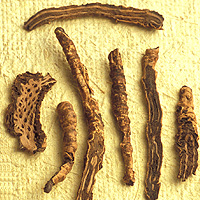Penn Herb Wellness Guide
Picrorhiza
 © Martin Wall
© Martin WallHow It Works
The major constituents in picrorhiza are the glycosides picroside I, kutkoside, androsin, and apocynin. They have been shown in animal studies to be antiallergic, to inhibit platelet-activating factor (an important pro-inflammatory molecule),3 and to decrease joint inflammation.4 According to test tube and animal studies, picrorhiza has antioxidant actions, particularly in the liver.5, 6 Picroliv (a commercial mixture containing picroside I and kutkoside) has been shown to have an immunostimulating effect in hamsters, helping to prevent infections.7 Picrorhiza increases bile production in the liver, according to rat studies.8 It has also been shown to protect animals from damage by several potent liver toxins, offering protection as good as or better than silymarin (the flavonoids found in milk thistle).9, 10 However, it does not have the amount of human research as silymarin. Picrorhiza has also shown to reduce formation of liver cancer due to chemical exposures in animal studies.11
Human studies on this plant are not prolific. A series of cases of acute viral hepatitis in India were reportedly treated successfully by a combination of picrorhiza with a variety of minerals.12 A number of similar reports have appeared in Indian literature over the years. No double-blind clinical trials have yet been published, however.
Two preliminary trials suggest that picrorhiza may improve breathing in asthma patients and reduce the severity of asthma.13, 14 Although, a follow-up double-blind trial did not confirm these earlier trials.15
A preliminary trial conducted in India found a small benefit for people with arthritis (primarily rheumatoid arthritis).16
Picrorhiza in combination with the drug methoxsalen was found in a preliminary trial to hasten recovery in people with vitiligo faster than those receiving methoxsalen and sun exposure alone.17
How to Use It
Between 400 and 1,500 mg of powdered, encapsulated picrorhiza per day has been recommended. One author considers this equivalent to the use of 12 ml of fluid extract twice per day.18 Picrorhiza tastes quite bitter. Combining with ginger root powder capsules or taking as tea can improve palatability.
Copyright 2025 TraceGains, Inc. All rights reserved.
Learn more about TraceGains, the company.
The information presented by TraceGains is for informational purposes only. It is based on scientific studies (human, animal, or in vitro), clinical experience, or traditional usage as cited in each article. The results reported may not necessarily occur in all individuals. Self-treatment is not recommended for life-threatening conditions that require medical treatment under a doctor's care. For many of the conditions discussed, treatment with prescription or over the counter medication is also available. Consult your doctor, practitioner, and/or pharmacist for any health problem and before using any supplements or before making any changes in prescribed medications. Information expires December 2025.


